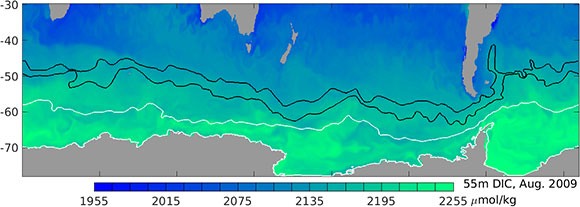When your study area is as large as the Southern Ocean, you have to plan carefully. Dr. Matthew Mazloff, a research affiliate of the Center for Climate Change Impacts and Adaptation, recently published a paper estimating spatial correlations on key properties in locations throughout the Southern Ocean, quantifying the number of observational stations needed to understand the “climate state”. The primary tool used in the assessment is a Biogeochemical Southern Ocean State Estimate, known as B-SOSE. B-SOSE assimilates in situ and satellite measurements, including those from Argo floats equipped with biogeochemical sensors, to determine oceanic inventories of carbon and heat.

To read the full paper, visit here.
Dr. Mazloff created an animation of simulated carbon flux from the Southern Ocean to the atmosphere from the 2008-2012 B-SOSE. You can view it here.
The full B-SOSE results and output from 2008-2012 can be found here.
B-SOSE is a contribution of the Southern Ocean Carbon and Climate Observations and Modeling project (SOCCOM) program, sponsored by the National Science Foundation, focused on unlocking the mysteries of the Southern Ocean and determining its influence on climate.
Learn more about Dr. Mazloff and our other Research Affiliates here.


